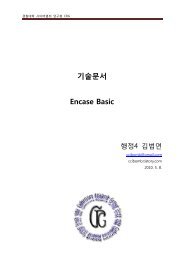Reverse Engineering Code with IDA Pro 2_1 [vangelis].pdf
Reverse Engineering Code with IDA Pro 2_1 [vangelis].pdf
Reverse Engineering Code with IDA Pro 2_1 [vangelis].pdf
You also want an ePaper? Increase the reach of your titles
YUMPU automatically turns print PDFs into web optimized ePapers that Google loves.
<strong>Reverse</strong> <strong>Engineering</strong> <strong>Code</strong> <strong>with</strong><br />
<strong>IDA</strong> <strong>Pro</strong><br />
By Dan Kaminsky, Justin Ferguson, Jason Larsen, Luis Miras, Walter Pearce<br />
정리: <strong>vangelis</strong>(securityproof@gmail.com)<br />
이 글은 <strong>Reverse</strong> <strong>Engineering</strong> <strong>Code</strong> <strong>with</strong> <strong>IDA</strong> <strong>Pro</strong>(2008년 출판)라는 책을 개인적으로 공부하면서<br />
정리한 것입니다. 목적이 책 소개가 아니라 공부이므로 글의 내용은 형식에 국한되지 않고 경우에<br />
따라 책의 내용 일부를 편역하거나 또는 철저하게 요약해서 올리고, 경우에 따라 필자가 내용을<br />
추가할 것입니다. 내용에 오류 및 오타가 있다면 지적 부탁 드립니다.
2장 Assembly and Reversing <strong>Engineering</strong> Basics<br />
개관 1<br />
이 장에서는 리버싱 엔지니어링을 위해 필요한 어셈블리어, Intel 아키텍처 프로세서, 명령어 등 기<br />
본적인 요소들을 소개하고 있다. 이 책은 32-bit Intel architecture(IA-32) 어셈블리어에 초점을 맞<br />
추고 있으며, 운영체계는 Windows와 Linux를 다루고 있다. 독자들은 IA-32 어셈블리어와 C/C++<br />
에 대한 이해도가 필요하다. 그렇다고 해서 이 장에서 관련 항목을 깊게 다루지는 않고 있다.<br />
어셈블리어와 IA-32 프로세서 2<br />
어셈블러(assembler)들은 다른 문장 구조(syntax)를 가지고 있다. 가장 대표적인 Intel과 AT&T 문장<br />
구조인데, 이 책에서는 Intel 문장 구조를 사용하고 있다. 이것은 <strong>IDA</strong>에 의해 사용되는 것이 Intel<br />
문장 구조이기 때문인 것도 있고, 각종 문서나 white paper에서도 더 많이 사용되기 때문이다.<br />
Intel과 AT&T 문장 구조의 차이점에 대해 다음 예를 보자. 다음은 간단한 “Hello, World” 프로그램<br />
이다. 첫 번째 것은 Red Hat 리눅스에서 gcc로 컴파일하고, gdb를 통해 디스어셈블링 한 것이다.<br />
Gdb를 통해 나오는 결과는 AT&T문장 구조이다.<br />
(gdb) disas main<br />
Dump of assembler code for function main:<br />
0x8048328 : push %ebp<br />
0x8048329 : mov %esp,%ebp<br />
0x804832b : sub $0x8,%esp<br />
0x804832e : and $0xfffffff0,%esp<br />
0x8048331 : mov $0x0,%eax<br />
0x8048336 : sub %eax,%esp<br />
0x8048338 : sub $0xc,%esp<br />
0x804833b : push $0x8048398<br />
0x8048340 : call 0x8048268 <br />
0x8048345 : add $0x10,%esp<br />
0x8048348 : mov $0x0,%eax<br />
1 2장에서는 시스템 해킹을 공부한 사람이라면 많이 접했던 분야이다. 그래서 아주 간단하게 정리를 할 생각<br />
이다.<br />
2 이 섹션에서 “Assembly refers to the use of instruction mnemonics…”라는 부분이 나온다. 여기서<br />
‘mnemonics’는 같은 기능을 가진 instruction opcode 클래스의 예약된 이름이다. “mov eax, 0”라는<br />
instruction의 포맷을 살펴보면, mov가 mnemocic이고, eax와 0은 operand가 되는 아규먼트들이다. 몇<br />
개의 오퍼랜드를 가질 것인가는 opcode에 따라 결정되며, 오퍼랜드의 수는 0 ~3까지이다.
0x804834d : leave<br />
0x804834e : ret<br />
0x804834f : nop<br />
End of assembler dump.<br />
(gdb)<br />
다음은 Dev-C++에서 컴파일 한 것을 <strong>IDA</strong> <strong>Pro</strong>로 본 것이다.<br />
;<br />
; +-----------------------------------------------------------------------+<br />
; | This file is generated by The Interactive Disassembler (<strong>IDA</strong>) |<br />
; | Copyright (c) 2007 by DataRescue sa/nv, |<br />
; | Licensed to: Mach EDV Dienstleistungen, Jan Mach, 1 user, adv, 11/2007|<br />
; +-----------------------------------------------------------------------+<br />
;<br />
; Input MD5 : 88FEF2313AAAB6E089DCD55EF42C7804<br />
; File Name : C:\Documents and Settings\free2\바탕 화면\test.exe<br />
; Format : Portable executable for 80386 (PE)<br />
; Imagebase : 400000<br />
; Section 1. (virtual address 00001000)<br />
; Virtual size : 000008D4 ( 2260.)<br />
; Section size in file : 00000A00 ( 2560.)<br />
; Offset to raw data for section: 00000400<br />
; Flags 60000060: Text Data Executable Readable<br />
; Alignment : default<br />
; OS type : MS Windows<br />
; Application type: Executable 32bit<br />
.686p<br />
.mmx<br />
.model flat<br />
.intel_syntax noprefix<br />
- 중략 -<br />
push ebp<br />
mov ebp, esp<br />
sub esp, 8
and esp, 0FFFFFFF0h<br />
mov eax, 0<br />
add eax, 0Fh<br />
add eax, 0Fh<br />
shr eax, 4<br />
shl eax, 4<br />
mov [ebp+var_4], eax<br />
mov eax, [ebp+var_4]<br />
call ___chkstk<br />
call ___main<br />
mov [esp+8+var_8], offset aHello ; "Hello"<br />
call printf<br />
mov eax, 0<br />
leave<br />
retn<br />
_main endp<br />
- 중략 -<br />
결과를 보면 파란색으로 표시한 .intel_syntax noprefix 부분을 보면 Intel 문장 구조를 사용<br />
하고 있음을 알 수 있다. printf() 함수가 호출되는 부분부터 두 문장 구조를 비교해보자.<br />
[AT&T 문장구조]<br />
0x8048340 : call 0x8048268 <br />
0x8048345 : add $0x10,%esp<br />
0x8048348 : mov $0x0,%eax //책에서는 xor %eax, %eax<br />
0x804834d : leave<br />
0x804834e : ret<br />
[Intel 문장구조]<br />
mov [esp+8+var_8], offset aHello ; "Hello"<br />
call printf<br />
mov eax, 0 //책에서는 xor eax, eax<br />
leave<br />
retn<br />
책에서는 “xor %eax, %eax”를 사용하고 있다. 이 연산 결과는 잘 알겠지만 eax 레지스터의 값
이 0이 된다. xor를 사용하고, 두 오퍼랜드가 같으면 그 오퍼랜드의 값은 0이 된다. 그리고<br />
“mov $0x0,%eax”의 결과를 보면 eax 레지스터에 0의 값을 복사한다. 결과는 당연 eax 레지스<br />
터의 값은 0이 된다. 책에 나오는 것과 필자의 테스트에서 나온 결과는 같은 것이다.<br />
우리가 주목할 것은 위의 두 결과를 보면 source operand와 destination operand의 위치가 다르다<br />
는 것이다. 정리하면 다음과 같다.<br />
* AT&T 문장구조 – 명령어 source operand, destination operand<br />
mov $0x0, %eax<br />
* Intel 문장구조 – 명령어 destination operand, source operand<br />
mov eax, 0<br />
다음 부분은 C언어에서는 “return 0;”을 나타낸다.<br />
mov eax, 0 // mov $0x0,%eax<br />
leave<br />
retn // ret<br />
프로세서는 ‘return 0;’이라는 것을 이해할 수 없다. 그런 의미에서 어셈블리어는 인간이 읽을 수<br />
있는 마지막 코드 층이라고 할 수 있다. 컴파일링 후에 코드를 어셈블링하면 ‘opcode’를 출력하는<br />
데, opcode는 어셈블리어 명령을 이진수 형태로 나타낸 것 또는 개별 명령을 실행하기 위해 필요<br />
한 on-off의 연속(sequence)이다. 보통 opcode는 이진수 보다는 16진수로 나타낸다.<br />
0x8048348 : mov $0x0,%eax<br />
0x804834d : leave<br />
0x804834e : ret<br />
0x804834f : nop<br />
End of assembler dump.<br />
(gdb) x/8b 0x8048348<br />
0x8048348 : 0xb8 0x00 0x00 0x00 0x00 0xc9 0xc3 0x90<br />
(gdb)<br />
이것을 objdump를 이용해 좀더 알기 쉽게 확인할 수 있다.<br />
8048348: b8 00 00 00 00 mov $0x0,%eax<br />
804834d: c9 leave<br />
804834e: c3 ret<br />
804834f: 90 nop
하지만 결국 컴퓨터의 프로세서에 전달되는 것은 1과 0의 연속이다. Opcode에 대한 좀더 자세한<br />
자료는 Intel® 64 and IA-32 Architectures Software Developer’s Manual Volume 2A3 의 section<br />
2.1.2를 참고하길 바란다. 4 이 책은 http://www.intel.com/products/processor/manuals/에서 <strong>pdf</strong> 파<br />
일로 구할 수 있으며, 책으로 받으려면 http://www.intel.com/design/literature.htm를 참고하면 된<br />
다. 참고로 이 책들은 무료이다. 신청하면 늦어도 2주 안으로 미국에서 한국으로 책이 배달된다.<br />
필자의 경우 매뉴얼 페이지에 있는 6 종류의 책을 신청하여 2개의 박스로 받았던 적이 있다.<br />
다음은 섹션 2.1.2의 원문 전체를 첨부한 것이다.<br />
**********************************************************************************************************<br />
2.1.2 Opcodes<br />
A primary opcode can be 1, 2, or 3 bytes in length. An additional 3-bit opcode field is sometimes<br />
encoded in the ModR/M byte. Smaller fields can be defined <strong>with</strong>in the primary opcode. Such fields<br />
define the direction of operation, size of displacements, register encoding, condition codes, or sign<br />
extension. Encoding fields used by an opcode vary depending on the class of operation.<br />
Two-byte opcode formats for general-purpose and SIMD instructions consist of:<br />
• An escape opcode byte 0FH as the primary opcode and a second opcode byte, or<br />
• A mandatory prefix (66H, F2H, or F3H), an escape opcode byte, and a second opcode byte<br />
(same as previous bullet)<br />
For example, CVTDQ2PD consists of the following sequence: F3 0F E6. The first byte is a<br />
mandatory prefix for SSE/SSE2/SSE3 instructions (it is not considered as a repeat prefix).<br />
Three-byte opcode formats for general-purpose and SIMD instructions consist of:<br />
• An escape opcode byte 0FH as the primary opcode, plus two additional opcode bytes, or<br />
• A mandatory prefix (66H), an escape opcode byte, plus two additional opcode bytes (same as<br />
previous bullet)<br />
For example, PHADDW for XMM registers consists of the following sequence: 66 0F 38 01. The first<br />
byte is the mandatory prefix.<br />
Valid opcode expressions are defined in Appendix A and Appendix B.<br />
**********************************************************************************************************<br />
3 http://download.intel.com/design/processor/manuals/253666.<strong>pdf</strong><br />
4 어떤 책을 공부하다 보면 각종 책이나 참고 자료들이 제시된다. 공부과정에서 그 참고 자료들도 같이 구해<br />
서 본다면 공부하고 있는 책 한 권을 제대로 이해할 수 있을 뿐만 아니라 더 많은 것을 이해할 수 있게<br />
될 것이다.
opcode에 대한 더 자세한 내용은 위의 첨부한 원문 끝 줄에 나오듯 Appendix A와 B에 나와 있다.<br />
그리고 Reversing <strong>Engineering</strong> <strong>Code</strong> <strong>with</strong> <strong>IDA</strong> <strong>Pro</strong>라는 이 책을 잘 이해하기 위해서는 Intel® 64<br />
and IA-32 Architectures Software Developer’s Manual Volume 2A, 2B 두 권이 늘 필요할 것이다.<br />
이 두 권은 instruction set reference에 대한 것이다.<br />
Tools & Traps…<br />
Shellcode는 보통 C언어에서 문자열 배열로 저장되는 일련의 opcode이다. ‘shellcode’라는 용어를<br />
사용하게 된 것은 그 일련의 opcode가 쉘(/bin/sh 또는 cmd.exe)을 실행하는데 필요한 명령어<br />
(instruction)들이기 때문이다.<br />
C언어에서 쉘코드를 사용하려면 다음과 같이 한다는 것을 이 글의 독자들은 다 알고 있을 것이다.<br />
unsigned char shellcode[] = “\xc9\x31\xc0\xc9”;<br />
쉘코드는 해킹에서 필수적인 요소이므로 관련 지식을 반드시 알아둘 필요가 있다. 쉘코드를 만드<br />
는 방법에 대해서는 국내외에 많은 자료들이 있으므로 그 자료들을 참고하길 바란다.<br />
To be continued…


![Reverse Engineering Code with IDA Pro 2_1 [vangelis].pdf](https://img.yumpu.com/17407486/1/500x640/reverse-engineering-code-with-ida-pro-2-1-vangelispdf.jpg)

![PC 어셈블리어 [이재범].pdf - Tistory](https://img.yumpu.com/17491210/1/184x260/pc-pdf-tistory.jpg?quality=85)




![Autoruns [hahaj1].pdf](https://img.yumpu.com/17491028/1/184x260/autoruns-hahaj1pdf.jpg?quality=85)
![Unpacking [ezbeat].pdf](https://img.yumpu.com/17490983/1/184x260/unpacking-ezbeatpdf.jpg?quality=85)
![IDA Remote Debugging [CodeEngn].pdf](https://img.yumpu.com/17490906/1/184x260/ida-remote-debugging-codeengnpdf.jpg?quality=85)
![dll과 cow [k0nni3].pdf](https://img.yumpu.com/17490887/1/184x260/dll-cow-k0nni3pdf.jpg?quality=85)
![TCP View란 [hahaj1].pdf](https://img.yumpu.com/17490864/1/184x260/tcp-view-hahaj1pdf.jpg?quality=85)

![기초 보안 용어의 이해 [superdk].pdf](https://img.yumpu.com/17490839/1/190x143/-superdkpdf.jpg?quality=85)

![FreeBSD Shellcode 만들기 [graylynx].pdf](https://img.yumpu.com/17490825/1/184x260/freebsd-shellcode-graylynxpdf.jpg?quality=85)